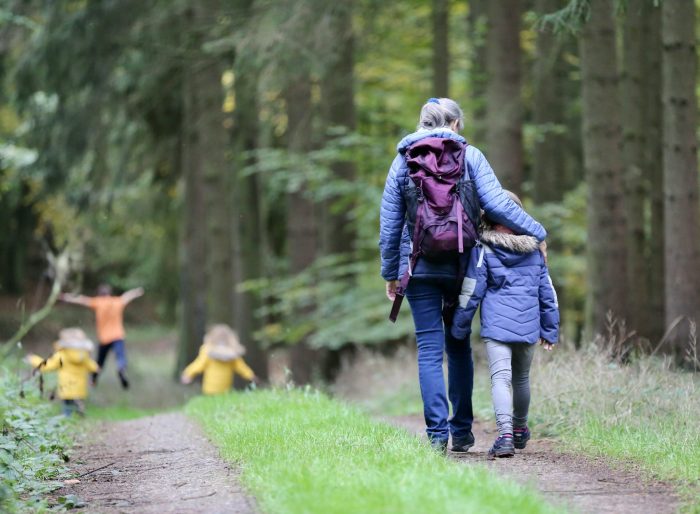*Did you know you can write on Elephant? Here’s how—big changes: How to Write & Make Money or at least Be of Benefit on Elephant. ~ Waylon
My daughters were privileged to have attended an alternative preschool that insisted on getting the kids outside for a walk every day—rain or shine.
Parents were instructed to have rain boots, rain coats, and even rain pants—plus a full change of clothes—for each child in a special clothing bag. As a parent in the diversely weathered state of Massachusetts, I will say that it was sometimes a pain to keep up with making sure there was a dry pair of socks, pants, and underwear every day in their bags.
However, I was delighted that my daughters received a true gift: they are scared of no weather and will go outdoors in all elements. They aren’t squeamish about mud. Or rain. They don’t complain about the cold New England winters; they just bundle up appropriately. (Occasionally, as teens, they wouldn’t wear a coat, but that’s developmentally appropriate, it seems.)
I appreciate my daughters’ foundational comfort around being active outside. They have a true sense of adventure in the outdoors and in life in general. As young adults, they’ve tried and enjoyed mountain hiking, snow sports, and walks in the rain. So many kids, teens, and adults that I’ve worked with develop a far more complicated relationship with physical activity and fitness.
I’m intentionally replacing the word “exercise” with “movement” because many of my clients and colleagues feel the term “exercise” has been weaponized and often turned into a “should.” “Movement” is a term that doesn’t seem to create the same feelings of shame and judgment. I’ll also note here that having safe spaces in which to move our bodies benefited my daughters and their classmates greatly. Some children don’t have inviting streets to walk on or access to safe places to play. And some children have bodies that don’t move in typical ways.
Moving our bodies should be fun and bring a joy-filled connection to body and self. Some kids are natural movers and need a lot of activity. They need encouragement to rest and take care of injuries and soreness that may come from using their bodies a lot, especially while growing.
One of my daughters, Kyla, is like this. She used to come home from sports practice proudly showing off her bleeding knees. She and I tend to overdo movement at times, as the energy release is an important self-regulator. Her twin sister, Ava, and my partner, Pasha, are both more naturally sedentary. While Kyla and I need to be reminded to rest and relax our bodies, Ava and Pasha occasionally need some movement to balance their love of chilling on the couch.
If your child moves slowly and likes restful activities, there is absolutely nothing wrong with this innate less-active preference, despite what the diet-and-fitness industry may say. While some exercise is health-encouraging for all bodies, some kids like intense and competitive sports activities, and some prefer solo pursuits, like swinging on a swing set. Different bodies find different activities joyful.
The key to whole-person health, as I see it, is to find activities that are both enjoyable and sustainable. As now young adults, Kyla plays ultimate frisbee and tries not to get concussions diving for the disc, while Ava enjoys what she calls “hot girl power walks” on her way to buy flowers and matcha tea for her friends.
Finding activities to complement your children’s various movement personalities can be difficult, especially when needs and preferences are different. That said, finding activities that are pleasurable and fun for kids will go a long way toward creating a healthy relationship with movement and a healthy connection to the body. Moving together as a family sets the foundation for appreciating some of the benefits of an active body, as well as helping kids develop skills around balance, teamwork, pacing one’s energy, healthy versus unhealthy competition, and the list goes on.
I want to say a few words here about ability. Obviously, different bodies are differently abled. Some children are natural athletes, and their bodies are well-coordinated. Some children have physical disabilities and are unable to move in the ways most humans get around in the world, sometimes requiring assistance from other humans and devices to allow that movement. Most children fall somewhere in between these extremes.
It’s important to honor and respect your child’s innate movement style and limitations. This may be hard if you are an athletic parent with a less physically active child—or a disabled parent with a hyperactive child. Awareness, compassion, and open communication can go a long way.
I have heard so many stories from adults who were shamed as children for their natural sedentary or less-coordinated way of moving about in the world. This shame often goes deep and leads to a complicated relationship with the body and physical activity. Shame may encourage some children and adults to feel cut off and disconnected from their bodies. Since the body is where we feel emotions like love, pleasures like comfort, and present-moment focus, it is truly heartbreaking to encounter someone who is cut off from the delights of being in a body because the pain and grief around connecting with the body has been too much.
Many of my clients share stories about how challenging it has been for them to be in their bodies because they believed their bodies were wrong or less desirable than others’ from a young age. While many kids and teens learn from adults and the internet that the reason to exercise is to “look better” or to lose weight, there are so many other reasons to encourage physical activity. For many, enjoying physical movement creates a foundation for a healthy, happy life.
Studies have documented that overall quality of life is rated significantly higher by those with physically active lifestyles, no matter their age and health status. Large-muscle movements lead to increased strength, stamina, and flexibility into old age. According to the Centers for Disease Control (CDC), physical activity benefits brain health, strengthens bones and muscles, and improves the ability to do everyday activities.
I don’t believe that being “active” for most people means going to the gym regularly, though that’s fine if you enjoy gyms. My grandparents lived into their 90s without gym workouts or special diets of any kind. I’m sure genetics was on their side, but I think being active and engaged in life must have played a role in their health. Housecleaning (her house was remarkably tidy), cooking, and actively engaging with grandkids were Nana’s main sources of “exercise,” and they served her well. “If you don’t move it, you lose it,” she always said.
Because computers and social media are so captivating for our kids and keep them in one place for many more hours than past generations, it’s particularly important that we encourage physical activity for balance and teach kids about the social, emotional, and health benefits of moving. However, shaming our children into moving their bodies may cancel out the health benefits of physical activity.
It’s also important not to tell children you are exercising to lose weight or to make up for what you ate the day before. This is not the best motivation for exercise. Instead of saying, “I had too much ice cream last night, and I need to go to the gym,” consider saying, “I had so much fun at my Zumba class. Will you dance with me in the kitchen to my favorite song from class?” or “I’m really looking forward to jumping in the pool. My body feels so good after a swim.”
Healthy habits can be encouraged for the whole family, and they should not be about changing your child’s or your weight. When physical activity gets tied to weight loss or compensating for food eaten, it creates a more compulsive and disordered relationship to fitness. Moving for the sake of pure joy and feeling good is more sustainable, and it allows for rest, too, when the body needs relaxation on any given day.
~
{Please consider Boosting our authors’ articles in their first week to help them win Elephant’s Ecosystem so they can get paid and write more.}












Read 5 comments and reply